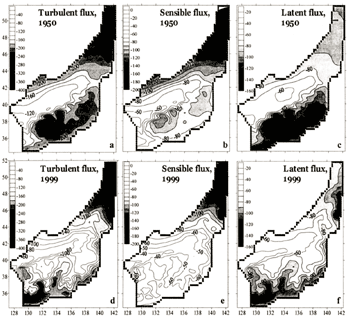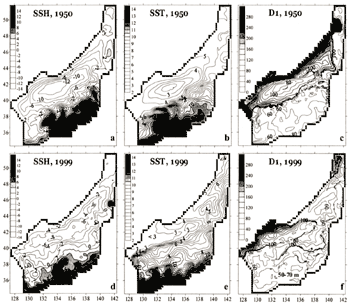|
Wintertime air - sea heat fluxes and convection
In both experiments large-scale spatial patterns of wintertime turbulent (sensible and latent) heat flux (Fig.4) simulated under constant wind speed forcing are consistent with ones based on observation data, such as in (Kawamura and Wu, 1998), estimated under synoptic wind forcing. These patterns should be associated with the difference between air temperature and SST (temperature of the model upper layer). Disagreement in some areas and quantitative underestimation of simulated heat fluxes are due to values adopted for wind speed, relative humidity, and climatic upward longwave radiation. Wintertime heat loss at the sea surface is high in the subtropical area of warm currents and higher SST and in the northern Japan Sea and Tatarsky Strait of lowest air temperature; latent heat flux is highest in the south and sensible heat flux is highest in the north (Figs.4, 5). Sensible heat flux exceeds latent flux in the area northward of 40°- 41°N in 1950 and northward of 42°- 43°N in 1999, as cold air cannot hold much moisture. An excess of sensible over latent flux is reported by Kawamura and Wu (1998) for the area northward of 44°N and area of increased flux off Vladivostok.
| (Enlarge: 116KB) |
 |
Figure 4. Wintertime net turbulent (a,d), sensible (b,e), and latent (c,f)
heat flux (wt/m2) on February 1 for the 1950 (a,b,c) and 1999 (d,e,f) Experiments
Heat flux is low inside the cyclonic gyre, due to low SST (Figs.4, 5). The area of minimum flux, decreasing westward, is stretched out along the southern subarctic front associated with the EKWC Extension, with the lowest flux off the Korea coast (Fig.4). This pattern is in agreement with (Kawamura and Wu, 1998). Turbulent heat flux, especially due to sensible flux, is increased in the area adjacent to Vladivostok (Fig.4) due to low air temperature caused by strong winter monsoon wind from continental Asia, although according to Kawamura and Wu (1998) "the flux center" off Vladivostok is shifted eastward. In the subtropical area, simulated patterns of net turbulent heat flux resemble patterns of SSH and upper layer temperature in both experiments (Figs.4, 5). In the 1999 Experiment, tongues of increased heat flux are simulated in the southern Japan Sea: along the Honshu Island, in the central region centered at 134°E, and in the western area. A tongue-shaped area of increased turbulent fluxes centered at 133°E appears over the Oki Bank in Kawamura and Wu (1998). Eastward shift of simulated flux maximum can be explained by variability of currents in this area (Kawabe, 1982).
In winter air - sea turbulent heat flux averaged over the sea, although underestimated in both experiments, is higher in 1950 than in 1999, namely 110 wt/m2 versus 74 wt/m2 for February. Wintertime latent and sensible fluxes are higher in the 1950 Experiment over most of the sea area, with two exceptions. In 1999 the western Japan Sea is occupied by warm surface and intermediate water associated with the intensified EKWC even in winter, while in 1950 the cyclonic gyre extends to 37°N, as seen from SSH distribution (Figs.5d, a). Therefore, heat loss is increased in this area in the 1999 Experiment (Figs.4b, e). In the eastern Japan Sea, branches of warm currents penetrate farther north in 1999 than in 1950, as seen from SSH distribution (Figs.5d, a). In winter surface water is warmer in the area off La Perouse Strait (Figs.5e, b) and air - sea heat flux is increased in 1999, compared to 1950 (Figs.4d, a).
Wintertime patterns of SSH, upper layer temperature, and convection depth match each other, with sharp fronts in convection depth along the current jets (Fig.5). Convection penetrates to greater density in the interior of cyclonlc gyres due to isopycnal doming. Simulated surface density is higher in the interior than at the margins of the cyclonic gyre: it is 27.12σθ versus 26.83-26.87σθ for 1950 and 27.02σθ versus 26.98σθ for 1999. However, the convection depth is increased at the cyclonic gyre margins (Fig.5). According to recent (winter 2000 and 2001) observations in the Japan Sea, evidence of deep convection is found at the southwest margin of the cyclonic gyre close to the subarctic front and at the northwest margin over the underwater seamount called Siberia (Talley et al., 2002). Compared to observations, the simulated SST is too high and convection depth and surface density are too low due to underestimated heat loss at the sea surface.
Convection simulated in the northwest Japan Sea was more intense in 1950 than in 1999 due to the higher heat loss at the sea surface and the intensified cyclonic gyre. However, in the interior of the cyclonic gyre, SST simulated under constant wind seed forcing is lower in 1999 than in 1950, with lower convection depth in 1999. This decrease is consistent with negative wintertime SST trend in the subarctic Japan Sea and Northwest Pacific found in observations (Ponomarev et al., 2003). On the contrary, simulated surface salinity in the cyclonic gyre interior is higher in 1950 than in 1999: 33.9-33.95 ppt versus 33.8-33.85 ppt. This increase implies that entrainment and upward buoyancy flux from the sea interior to the surface layer is higher in 1950 than in 1999, consistent with the intensified cyclonic gyre.
| (Enlarge: 115KB) |
 |
Figure 5. Sea surface height (cm; a, d), upper layer temperature (℃; b,
e), and convection depth (m; c, f) on February 1 for the 1950 (a, b, c) and 1999 (d, e, f) Experiments
CONCLUSIONS
Inflow transport across the Tsushima Strait is redistributed in favor of the eastern branches of the Tsushima Current in conditions of decreased baroclinicity in the mid 20th century and in favor of the western branch (East Korea Warm Current; EKWC) in conditions of increased baroclinicity in the late 20th century. The EKWC intensified in the 1990s supplies heat to the northwest Japan Sea, in contrast with the situation in the 1950s characterized by southeastward expansion of the intensified cyclonic gyre. In both cases, heat is advected to the northwest Japan Sea from the east with the westward branch of the Tsushima Current Extension. Realistic large-scale spatial patterns of wintertime turbulent heat flux from the Japan Sea surface to the atmosphere are simulated under constant wind speed forcing. Wintertime heat loss at the sea surface was higher in the cold conditions of the mid 20th century over most of the Japan Sea, with the exception of the western Sea and an area off La Perouse Strait where heat loss is higher in the late 20th century. In the climatic conditions of the mid 20th century, winter convection in the northwest Japan Sea was facilitated by the intensified cyclonic gyre. Further research of modeling of the Japan Sea circulation will be implemented under forcing of synoptic winds.
REFERENCES
Danchenkov, M.A., V.B. Lobanov, and A.A. Nikitin. 1997. Mesoscale eddies in
the Japan Sea, their role in circulation and heat transport. In Proceedings of CREAMS'97 International
Symposium, January 26-31, 1997, Fukuoko, Japan, 81-84.
Kawabe, M. 1982. Branching of the Tsushima Current in the Japan Sea, Part I.
Data analysis. J. Oceanogr. Soc. Japan. 38(4):95-107.
Kawamura, H., and P.Wu. 1998. Formation mechanism of the Japan Sea proper water
in the flux center off Vladivostok. J. Geophys. Res. 99(C12):25081-25091.
Ponomarev, V.I., D.D. Kaplunenko, and H. Ishida. 2001a. The 20th century climate
change in the Asian-Pacific Region. In Oceanography of the Japan Sea, Proceedings of CREAMS'2000 International
Symposium, edited by M.A. Danchenkov, 129-136. Russia, Vladivostok: Dalnauka.
Ponomarev, V.I., O.O. Trusenkova, and L.D. Talley. 2001b. Simulation of the
Japan Sea circulation in summer 1999 using the MHI layered model. In Oceanography of the Japan Sea,
Proceedings of CREAMS'2000 International Symposium, edited by M.A. Danchenkov, 104-111, Vladivostok:
Dalnauka.
Ponomarev, V.I., D.D. Kaplunenko, V. Krokhin, and H. Ishida. 2003. Climate
change in the Northeast Asia and Northwest Pacific during 20th century. In this volume.
Seung, Y.H. 1992. A simple model for separation of East Korean Warm Current
and formation of North Korean Cold Current. J. Oceanological Society Korea. 27(3): 189-196.
Shapiro, N.B. 1998. Formation of the Black Sea general circulation considering
stochastic wind stress. Marine Hydrophysical Journal (In Russian), 6: 26-40.
Sizova, Yu.V. 1961. The Japan Sea circulation. In General features of the
Japan Sea geology and hydrology, edited by V.N. Stepanov, 146-154 (in Russian). Moscow: Ac. Sci. USSR
Publ.
Talley, L.D., V. Lobanov, V. Ponomarev, A. Salyuk, P. Tishchenko, I. Zhabin, and S. Riser. 2002. Deep convection and brine rejection in the Japan Sea. Science (submitted).
Trusenkova, O., V. Ponomarev, and H. Ishida. 2003. Impact of climate change
on circulation patterns in the Japan Sea. Journal of Hydraulic, Coastal and Environmental Engineering.
JSCE (in print).
Yoon, J.H., and H. Kawamura. 2002. The formation and circulation of the intermediate
water in the Japan Sea. Journal of Oceanography, 55(2): 197-211.
|